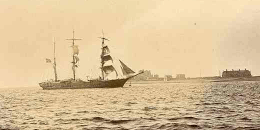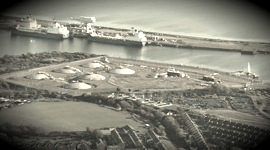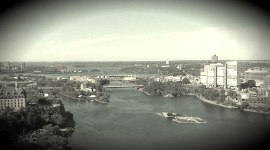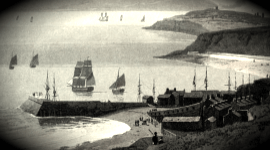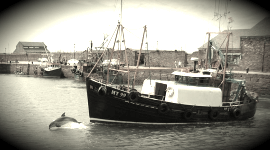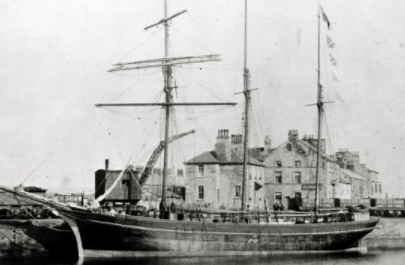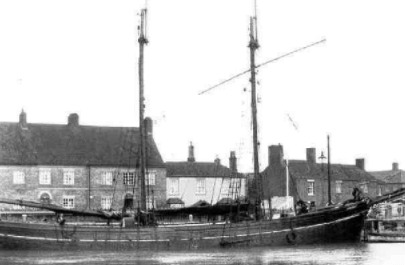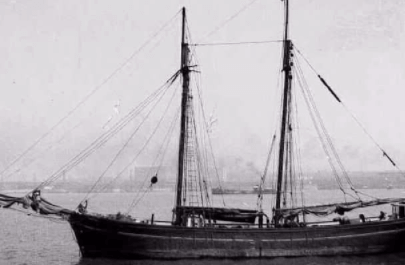The yacht Rose
Racing regattas had been held as early as the 1850's at Barrow, usually at the south end of Walney Channel around Piel and Roa Islands. These were at first organised by yacht clubs from outside the area, and it was only in June 1871 that the Barrow Yacht Club was formed and held its first races. At that time there were 42 yachts owned by its members. Amongst them were Thomas and Richard Ashburner, the Barrow shipbuilders and shipowners, who both were enthusiastic yachtsmen. Barrow's founding fathers were as well represented at the club as in all of Barrow's new ventures - the Duke of Buccleuch was Commodore and Sir James Ramsden was Vice-Commodore. Men such as these saw yachting as only a further means by which to demonstrate their wealth and achievement, and Ramsden, H.W. Schneider, James Fisher and others confined themselves to cruising in their own luxuriously-appointed steam yachts. In 1878 the club received the Royal approval and became the Royal Barrow Yacht Club, Thomas Ashburner later becoming its Honorary Secretary. He and his brother were yachtsmen in the true sense, and their interest in racing produced remarkable success, principally in boats they had designed and built themselves.

At least nine of the Ashburners' yachts are recorded in Lloyd's Register of Yachts, which only started in 1872. All of them were less than 40 ft. in overall length. The first was Daisy, a two-ton cutter designed by Richard Ashburner and launched in 1878. She was followed by two larger cutters, Salmo and Rose, launched in May, 1880. Rose was lengthened by two feet in the following year to bring her to 27 feet 8 inches overall, with a beam of 8 feet and a draft of 6 feet 6 inches. She was later bought by a Liverpool owner and by 1889 had been renamed Lu-lu. It can be assumed that the hull form evolved from that of the 'nobby', boats adapted for speed in the face of the short, steep seas characteristic of Morecambe Bay. This is particularly evident in the long run aft to a low counter stern. At the bows the entrance is much deeper and sharper, a considerable development from that of the straight-stemmed, bluff-bowed trawl boats. The sail plan is also very similar to that of a 'nobby', though for racing the cutter rig was augmented by a spinnaker.
Further yachts followed Rose at regular intervals. A three-ton cutter, Lily was built in 1882/3. By 1889 she was owned in Hamburg. Rosebud was built in 1884. The largest of the Ashburners' yachts was the eight-ton Red Rose. She was designed by the Glasgow designer G.L. Watson and was built in 1890. Their final two yachts were Primrose and White Rose. Unlike all her predecessors, Primrose, launched in 1895, was rigged as a sloop.
The Ashburner yachts were highly successful. Rose, Rosebud and Red Rose all won trophies from the RBYC in their first year of competition. Red Rose was owned jointly by Thomas and Richard and she was sold in 1897 for £200. The two brothers invested the money in what was to become their most successful and famous yacht, White Rose.
The Ashburners' racing success was largely local, against similar yachts built at Morecambe Bay and Duddon boatyards. The enduring success of White Rose, built in 1899, gives a better perspective on Richard Ashburner's qualities as a yacht designer. White Rose was originally a 30 ft. cutter of 6 tons, carrying just under 700 square feet of sail. She was soon lengthened three times, doubling her tonnage and bringing her to 39 ft. 6 ins. overall. With this increase in hull size came more sail, so that in her final form the Ashburners raced her with two jibs, a gaff topsail and a mainsail totalling 900 square feet. The Ashburners, both in their sixties by then, raced her themselves and were reportedly almost invincible in local races.
The Ashburners ceased to appear in Lloyd's Register as builders in 1903, and as owners ten years later. According to the Register they still owned White Rose but she was sold during the First World War, soon after Thomas Ashburner had died. Her new owner removed her keel to profit from the then inflated price of lead. By the end of the War she was in new ownership and was not sailed again until 1925. With the yacht in a decrepit state, her owner decided to raffle her and she was won by a local yachtsman, Dr. Coffey. He refitted her, though giving her only an iron keel. She re-entered the local racing scene, again winning most of her races, and in 1928 she took the record for the passage from Douglas to Barrow's Piel Island. The Second War interrupted her career and she was again laid-up. In 1949 Fred Rollinson bought her and restored her to her former grandure, though with a more modern sail plan of only a 450 sq.ft. mainsail and 150 sq.ft. jib. She was again a winner, and in 1973 won the North West Veterans and Old Gaffers Race.
